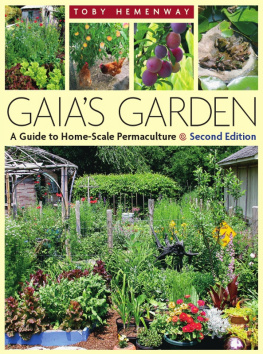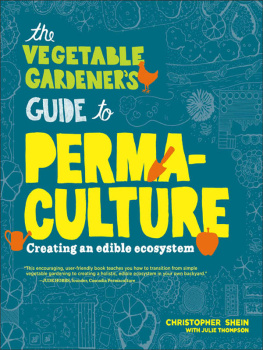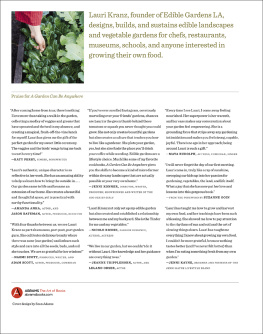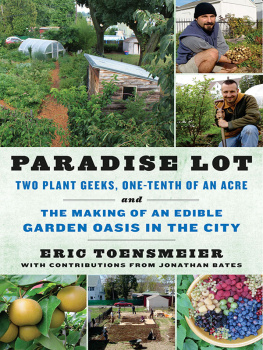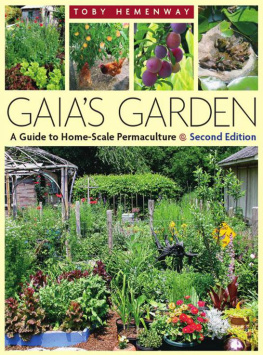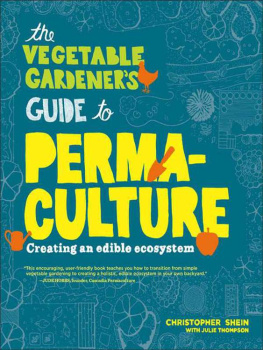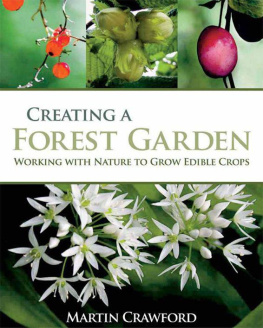GAIAS GARDEN
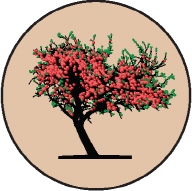
GAIAS GARDEN
A Guide to Home-Scale Permaculture

Toby Hemenway
CHELSEA GREEN PUBLISHING COMPANY
WHITE RIVER JUNCTION, VERMONT
Copyright 2000, 2009 by Toby Hemenway
Unless otherwise noted, all photographs copyright 2009 Toby Hemenway.
Unless otherwise noted, all illustrations copyright 2009 Elayne Sears.
All rights reserved. No part of this book may be transmitted or reproduced in any form by any means without permission in writing from the publisher.
Project Manager: Patricia Stone
Developmental Editor: Ben Watson
Copy Editor: Margaret Pinette
Proofreader: Janice Ronish
Designer: Peter Holm, Sterling Hill Productions
Printed in the United States of America
First printing, April 2009

Chelsea Green Publishing is committed to preserving ancient forests and natural resources. We elected to print this title on 10-percent postconsumer recycled paper, processed chlorine-free. As a result, for this printing, we have saved:
29 Trees (40' tall and 6-8" diameter)
13,293 Gallons of Wastewater
9 million BTUs Total Energy
807 Pounds of Solid Waste
2,760 Pounds of Greenhouse Gases
Chelsea Green Publishing made this paper choice because we are a member of the Green Press Initiative, a nonprofit program dedicated to supporting authors, publishers, and suppliers in their efforts to reduce their use of fiber obtained from endangered forests. For more information, visit www.greenpressinitiative.org.
Environmental impact estimates were made using the Environmental Defense Paper Calculator. For more information visit: www.papercalculator.org.
Our Commitment to Green Publishing
Chelsea Green sees publishing as a tool for cultural change and ecological stewardship. We strive to align our book manufacturing practices with our editorial mission and to reduce the impact of our business enterprise on the environment. We print our books and catalogs on chlorine-free recycled paper, using vegetable-based inks whenever possible. This book may cost slightly more because we use recycled paper, and we hope youll agree that its worth it. Chelsea Green is a member of the Green Press Initiative (www.greenpressinitiative.org), a nonprofit coalition of publishers, manufacturers, and authors working to protect the worlds endangered forests and conserve natural resources.
.
Library of Congress Cataloging-in-Publication Data
Hemenway, Toby, 1952
Gaias garden : a guide to home-scale permaculture / Toby Hemenway. -- 2nd ed.
p. cm.
Includes bibliographical references.
eBook ISBN: 978-1-60358-223-0
1. Natural landscaping. 2. Organic gardening. 3. Permaculture. 4. Gaia hypothesis. I. Title.
SB439.H44 2009
635.048--dc22
2009000785
Chelsea Green Publishing Company
Post Office Box 428
White River Junction, VT 05001
(802) 295-6300
www.chelseagreen.com
For Kiel
And in loving memory of my parents,
Tee and Jackie,
and my sister Leslie
CONTENTS
Appendix A Sampling of Useful Plants
W hen the first edition of Gaias Garden was in press, the staff at Chelsea Green, my agent, and I had animated discussions about whether the word permaculture should appear on the cover of the book. Back in 2000, few people had heard the term, and we all had our doubts about using it. Would the word entice potential readers or just baffle them? In the intervening years, permaculture, though it hasnt quite become a household word, has popped up in the media, been taught at several dozen universities, and grown a grass-roots network of many thousands of practitioners. Hence, in this edition I felt comfortable with dipping a little deeper into the nature of permaculture. If you still dont know what permaculture is, the first chapter will help explain it.
Although permaculture embraces many disciplines, most people come to it through gardening and their love of plants. Thus, though the permacultural aspects of this book are more overt in this expanded edition, the book remains garden focused rather than a sweeping guide to all aspects of sustainability.
A second change needing some explanation has occurred in the years since the first edition. When I first wrote Gaias Garden, we lived on ten mostly forested acres outside Oakland, Oregon, a village of 850 in very rural Douglas County. This was where I learned the concepts and methods described in the book, and I refer to our Oakland home often. But life is constant change, and many circumstances, including the success of this book, meant that we needed to be nearer to people. We have since moved north by a three-hour drive to Portland, Oregon, and now live on a small urban lot. This forced two changes in the book: The references to our southern Oregon home are now in the past tense, and I have added a chapter on urban permaculture gardening. The books focus has always been on the typical North American yard of one-quarter acre or less, but city living and landscaping pose a unique set of challenges and opportunities for ecological gardening in smaller spaces. Since three-quarters of the people on this continent live in metropolitan areas, I wanted to provide all of us, even those with no yard at all, with tools for using our landscapes to reduce our ecological footprint and become more self-reliant, while enhancing habitat for increasingly threatened wildlife.
This book began when I visited a garden that felt unlike any I had seen.
Walking in an ancient forest or snorkeling in a coral reef, I have felt an aliveness, a sense of many interlocking pieces clicking together into a living and dynamic whole. These are places that naturally exude abundance. Sadly, this feeling was lacking in any human-made landscape I had experienced. Natural landscapes seem so rich; they seethe with activity; they hum with life in comparison to our own. Why is it that nature can splash riotous abundance across forest or prairie with careless grace, while we humans struggle to grow a few flowers? Why do our gardens offer so little to the rest of life? Our yards seem so one-dimensional, just simple places that offer a few vegetables or flowers, if that much. Yet nature can do a thousand things at once: feed insects and birds, snakes and deer, and offer them shelter; harvest, store, and purify water; renew and enrich the soil; clean the air and scent it with perfume; and on and on.
Then I encountered a garden that had the vivid aliveness of nature, yet it was packed with fruit and edible greens. Soon I found a few others like it. In these places, using new techniques from permaculture and ecological design and old ones from indigenous people and organic gardening, a growing band of pioneers has created landscapes that feel like nature but provide an abundant home for people as well. These are true backyard ecosystems that were designed with methods and concepts gleaned from nature and that feel as alive as any forest. I wanted to know how to create these places, and I wanted to help others create more. Gaias Garden is the result.
These gardens represent a new landscape, one that provides for people as well as for the rest of nature. You could think of them as edible landscaping meets wildlife gardening, but they are more than that. These are true backyard ecosystems not just disconnected fragmentsthat are as resilient, diverse, productive, and beautiful as those in nature. They are not merely flowery showplaces or ruler-straight arrays of row crops. Yet they also are not the brambly tangles that identify many wildlife gardens. They are places where conscious design has been melded with a respect and understanding of natures principles. The result is a living and riotously abundant landscape in which all the pieces work together to yield food, flowers, medicinal and edible herbs, even craft supplies and income for the human inhabitants, while providing diverse habitat for helpful insects, birds, and other wildlife. Places where nature does most of the work, but where people are as welcome as the other inhabitants of Earth.
Next page
